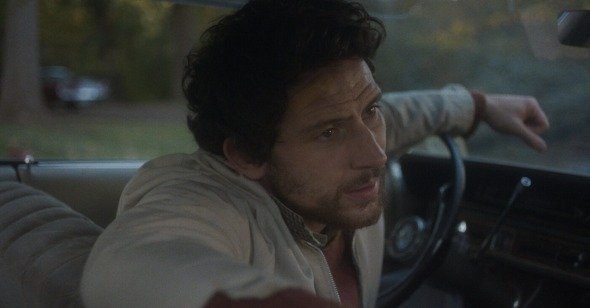Ordinary Genius
By Eileen G’Sell
New York Film Festival 2025:
The Mastermind
Dir. Kelly Reichardt, U.S., MUBI
Kelly Reichardt is into life’s losers—whether they lose due to circumstances beyond their control, a series of poor decisions, or (most often) both. There’s Wendy (Michelle Williams), the quiet drifter of Wendy and Lucy (2008), who filches a can of dog food only to lose her dog as a result. There’s Cookie (John Magaro) of First Cow (2020), a hapless cook who steals milk from the heifer of an 1820 Oregon landowner. And now, in Reichardt’s The Mastermind, there’s James Blaine Mooney (Josh O’Connor), a desultory art school dropout dispirited with domestic life in 1970 Massachusetts.
That the film’s plot once again hinges on theft—in this case purloining paintings from the local art museum—is of a piece with director’s larger oeuvre. And, as usual, the moral repercussions of stealing are not the film’s concern; private property, to Reichardt, is never really the point. What is the point is how the act itself spills over onto others’ realities, from James’s own life to his suburban brood to those he encounters while on the run from the law.
James is an outlier in the Reichardt canon as his loser status seems entirely earned; he’s white, middle-class, tall, and good-looking in a time when that counted even more than it does today. The son of a Circuit County judge, he shares a modest ranch house with his secretary wife Terri (Alana Haim) and two delightfully quirky, shaggy-haired sons. Why would the son of a retired judge attempt to pull off an art heist? Perhaps because he is just arrogant enough to think he can get away with it, based on getting away with so much in his 30-plus years. And perhaps because, not unlike Reichardt’s more sympathetic protagonists, he wants life to change in some extraordinary way. And even if that’s not a reason to root for him, it’s enough to keep us curious about what will happen next.
O’Connor plays James as perpetually perplexed as he is self-absorbed, but with a sheepishness it’s hard not to like. He’s pale, a bit schlubby, and stoops like a man unsure in his shoes (often a pair of unassuming Keds). His mother Sarah (Hope Davis) is frustrated by his fecklessness, but she floats him money anyway. Part of the odd pleasure of the film is witnessing everyone put up with James, then one by one decide that they won’t.
As per Reichardt’s slow cinema approach, The Mastermind takes off as a film when the heist plot has petered out. It is best in the lingering, liminal moments where the visual details onscreen tell us more, and more honestly, than the characters ever could: the fiery autumn leaves clashing over the museum steps, a baby’s moonlit face on an inter-city bus, the “We Want You” Army poster at a humble Rust Belt bus station. Cobbed corn is carefully cracked in half at the dining room table; the sound of an egg fried by a resentful wife can be absolutely devastating,
More than any other recent movie that comes to mind, The Mastermind reflects early 1970s America in a way that truly looks and sounds like it did in films from the time—from the elastic waist on Terri’s corduroy bell bottoms to the plastic fruit magnets festooning the fridge, from the fluctuation between Cloris Leachman bouffants and the long, unruly manes and beards on the youth at the nearby college campus. In a repeat moment of comedy early on, the crank handle on the station wagon stolen for the heist must be manually swiveled in order to open the back window and deposit the loot. James clearly lacks the foresight of a true mastermind.
His obliviousness to anything beyond his chain link fence gestures to the political and cultural schism dividing much of America—between draft dodgers and patriots, rioters and the police, those fine with the status quo and those earnestly believing that things can change for the better. It’s a time of eerie similarities to today, the connections Reichardt nudges, rather than elbows, us to discover as the film unfurls.
What is the role of art in this space? James sets his sight on four abstract paintings by Arthur Dove, which strangely fit in his living room as much as in the museum gallery he steals them from. At the inn where James hatches his final plan, the walls are lined with kitschy paintings of oversized iridescent cats and dogs. At the entrance of his room hangs a depiction of a pink cow jumping over the moon. Reichardt, herself a former art student (and the daughter of a cop), has long been invested in both the power of art and the art world’s pretenses (remember the cheese plate in Showing Up?). For all his self-regard, James, we suspect, will not run away with the spoon.
That he is ultimately handcuffed for reasons that have nothing to do with his arrest warrant, indeed nothing to do with his actual guilt, serves as a final irony that skewers any notion that justice is possible—both for the perpetrators of wrongdoing and those victimized by them. In Reichardt’s universe, losers never win, and even those, like James, who are dealt a winning hand could lose it all when their luck runs out. What redeems her vision from fatalism is the faith that “winning” itself is an empty goal, both for her protagonists and for those who follow them in the audience.
In the film’s last shot, outside the courthouse in downtown Cincinnati, a group of police officers banter after violently quashing an anti–Vietnam War rally. In the middle ground, a street sign reads “Watts,” a subtle reminder that public unrest isn’t particular to this particular city at this particular time—as well as Reichardt’s distinct capacity to capture the universal in the specific, to wrest beauty from the undeniably banal.
